A Multi-Dimensional Analysis of El Niño on Twitter: Spatial, Social, Temporal, and Semantic Perspectives
Abstract
:1. Introduction
2. Previous Work
2.1. Analysis of Social Media from Spatial, Temporal, Social, or Semantical Dimensions
2.2. Data Quality and Bias
3. Data Collection
4. Pre-Processing of the Twitter Data
4.1. Geocoding the Twitter Data
- if a tweet contained explicitly geographical coordinates, the coordinates were to be used directly without geocoding;
- if a tweet did not include coordinates, the tagged place name in the tweet metadata was used in geocoding;
- if a tweet did not have coordinates or a tagged place name, the location information listed on the user’s profile was used in geocoding;
- and, if a tweet did not contain any information as listed above, it was to be abandoned or ignored.
4.2. Identifying Topics in Tweets
4.3. Sentiment Calculation
4.4. Social Network Construction
- Frequency: The number of times an item, e.g., a hashtag or a Twitter user, has been mentioned in the collected tweets of one topic;
- Degree: The number of times an item is associated with other items, e.g., how many different hashtags/Twitter users are mentioned together with this hashtag/Twitter user in one topic:
- ○
- Indegree: In a directed network, the indegree is the number of ties an item receives from other items.
- ○
- Outdegree: In a directed network, the outdegree is the number of ties an item constructs toward other items.
- Eigenvector centrality: measure the influence of Twitter users or hashtags in networks. Weighted Eigenvector is calculated where the frequency is the weight.
4.5. Data Quality and Bias
5. Multi-Dimension Analysis
5.1. When and Where Do People Discuss El Niño
5.2. The Different Foci in Tweets
5.3. The Impact of Geopolitical Environment on Twitter Discussion
6. Discussion and Conclusions
Author Contributions
Acknowledgments
Conflicts of Interest
References
- Bickerstaff, K.; Walker, G. Public understandings of air pollution: the ‘localisation’of environmental risk. Glob. Environ. Chang. 2001, 11, 133–145. [Google Scholar] [CrossRef]
- Goodchild, M.F.; Glennon, J.A. Crowdsourcing geographic information for disaster response: a research frontier. Int. J. Digit. Earth 2010, 3, 231–241. [Google Scholar] [CrossRef]
- Huang, Q.; Xiao, Y. Geographic Situational Awareness: Mining Tweets for Disaster Preparedness, Emergency Response, Impact, and Recovery. Isprs Int. J. Geo-Inf. 2015, 4, 1549–1568. [Google Scholar] [CrossRef] [Green Version]
- Williams, H.T.P.; McMurray, J.R.; Kurz, T.; Hugo Lambert, F. Network analysis reveals open forums and echo chambers in social media discussions of climate change. Glob. Environ. Chang. 2015, 32, 126–138. [Google Scholar] [CrossRef]
- Wang, Z.; Ye, X. Social media analytics for natural disaster management. Int. J. Geogr. Inf. Sci. 2018, 32, 49–72. [Google Scholar] [CrossRef]
- Bosch, T. Blogging and tweeting climate change in South Africa. Ecquid Novi Afr. J. Stud. 2012, 33, 44–53. [Google Scholar] [CrossRef]
- Chen, X.; Elmes, G.; Ye, X.; Chang, J. Implementing a real-time Twitter-based system for resource dispatch in disaster management. GeoJ 2016, 81, 863–873. [Google Scholar] [CrossRef]
- Kirilenko, A.P.; Stepchenkova, S.O. Public microblogging on climate change: One year of Twitter worldwide. Glob. Environ. Chang. 2014, 26, 171–182. [Google Scholar] [CrossRef]
- Ripberger, J.T.; Jenkins-Smith, H.C.; Silva, C.L.; Carlson, D.E.; Henderson, M. Social Media and Severe Weather: Do Tweets Provide a Valid Indicator of Public Attention to Severe Weather Risk Communication? Weather Clim. Soc. 2014, 4, 520. [Google Scholar] [CrossRef]
- Palen, L.; Vieweg, S.; Liu, S.B.; Hughes, A.L. Crisis in a Networked World: Features of Computer-Mediated Communication in the April 16, 2007, Virginia Tech Event. Soc. Sci. Comput. Rev. 2009, 27, 467–480. [Google Scholar] [CrossRef]
- Kasperson, R.E.; Renn, O.; Slovic, P.; Brown, H.S.; Emel, J.; Goble, R.; Kasperson, J.X.; Ratick, S. The social amplification of risk: A conceptual framework. Risk Anal. 1988, 8, 177–187. [Google Scholar] [CrossRef]
- Bickerstaff, K. Risk perception research: socio-cultural perspectives on the public experience of air pollution. Environ. Int. 2004, 30, 827–840. [Google Scholar] [CrossRef] [PubMed]
- Wang, Z.; Ye, X.; Tsou, M.-H. Spatial, temporal, and content analysis of Twitter for wildfire hazards. Nat. Hazards 2016, 83, 523–540. [Google Scholar] [CrossRef]
- Cutter, S.L.; Boruff, B.J.; Shirley, W.L. Social Vulnerability to Environmental Hazards. Soc. Sci. Q. 2003, 84, 242–261. [Google Scholar] [CrossRef]
- Baxter, J.; Greenlaw, K. Explaining perceptions of a technological environmental hazard using comparative analysis. Can. Geogr. Tor. 2005, 49, 61–80. [Google Scholar] [CrossRef]
- Mohaimin, S.A.; Ukkusuri, S.V.; Hugh, G. The Role of Social Networks and Information Sources on Hurricane Evacuation Decision Making. Nat. Hazards Rev. 2017, 18, 04017005. [Google Scholar]
- Sadri, A.M.; Ukkusuri, S.V.; Gladwin, H. Modeling joint evacuation decisions in social networks: The case of Hurricane Sandy. J. Choice Model. 2017, 25, 50–60. [Google Scholar] [CrossRef]
- Klonner, C.; Usón, T.J.; Marx, S.; Mocnik, F.B.; Höfle, B. Capturing Flood Risk Perception via Sketch Maps. Isprs. Int. J. Geo-Inf. 2018, 9, 359. [Google Scholar] [CrossRef]
- Graham, C.; Thompson, C.; Wolcott, M.; Pollack, J.; Tran, M. A guide to social media emergency management analytics: Understanding its place through Typhoon Haiyan tweets. Stat. J. Iaos. 2015, 31, 227–236. [Google Scholar] [CrossRef] [Green Version]
- Veltri, G.A.; Atanasova, D. Climate change on Twitter: Content, media ecology and information sharing behavior. Public Underst. Sci. 2017, 26, 721–737. [Google Scholar] [CrossRef]
- Pearce, W.; Holmberg, K.; Hellsten, I.; Nerlich, B. Climate Change on Twitter: Topics, Communities and Conversations about the 2013 IPCC Working Group 1 Report. PLoS ONE 2014, 9, 1–11. [Google Scholar] [CrossRef] [PubMed]
- Ukkusuri, S.; Zhan, X.; Sadri, A.; Ye, Q. Use of Social Media Data to Explore Crisis Informatics. Transp. Res. Rec. J. Transp. Res. Board 2014, 2459, 110–118. [Google Scholar] [CrossRef]
- Cody, E.M.; Reagan, A.J.; Mitchell, L.; Dodds, P.S.; Danforth, C.M. Climate Change Sentiment on Twitter: An Unsolicited Public Opinion Poll. PLoS ONE 2015, 10, 1–18. [Google Scholar] [CrossRef] [PubMed]
- Yamagata, Y.; Murakami, D.; Peters, G.W.; Matsui, T. A spatiotemporal analysis of participatory sensing data ‘tweets’ and extreme climate events toward real-time urban risk management. arXiv 2015, arXiv:150506188. [Google Scholar] [CrossRef]
- Sisco, M.R.; Bosetti, V.; Weber, E.U. When do extreme weather events generate attention to climate change? Clim. Chang. 2017, 143, 227–241. [Google Scholar] [CrossRef]
- Kirilenko, A.P.; Molodtsova, T.; Stepchenkova, S.O. People as sensors: Mass media and local temperature influence climate change discussion on Twitter. Glob. Environ. Chang. 2015, 30, 92–100. [Google Scholar] [CrossRef]
- Kim, I.-H.; Feng, C.-C.; Wang, Y.-C.; Spitzberg, B.H.; Tsou, M.-H. Exploratory Spatiotemporal Analysis in Risk Communication during the MERS Outbreak in South Korea. Prof. Geogr. 2017, 69, 629. [Google Scholar] [CrossRef]
- Allen, C.; Tsou, M.-H.; Aslam, A.; Nagel, A.; Gawron, J.-M. Applying GIS and Machine Learning Methods to Twitter Data for Multiscale Surveillance of Influenza. PLoS ONE 2016, 11, 1–10. [Google Scholar] [CrossRef]
- Liu, J.C.-E.; Zhao, B. Who speaks for climate change in China? Evidence from Weibo. Clim. Chang. 2017, 140, 413–422. [Google Scholar] [CrossRef]
- Sadri, A.M.; Hasan, S.; Ukkusuri, S.V.; Cebrian, M. Understanding Information Spreading in Social Media during Hurricane Sandy: User Activity and Network Properties. arXiv 2017, arXiv:170603019 Cs. [Google Scholar]
- Sadri, A.M.; Hasan, S.; Ukkusuri, S.V.; Lopez, J.E.S. Analyzing Social Interaction Networks from Twitter for Planned Special Events. arXiv 2017, arXiv:170402489 Cs. [Google Scholar]
- Sadri, A.M.; Hasan, S.; Ukkusuri, S.V.; Cebrian, M. Crisis Communication Patterns in Social Media during Hurricane Sandy. arXiv 2017, arXiv:171001887 Cs. [Google Scholar] [CrossRef]
- Kryvasheyeu, Y.; Chen, H.; Moro, E.; Hentenryck, P.V.; Cebrian, M. Performance of Social Network Sensors during Hurricane Sandy. PLoS ONE 2015, 10, e0117288. [Google Scholar] [CrossRef]
- Kryvasheyeu, Y.; Chen, H.; Obradovich, N.; Moro, E.; Hentenryck, P.V.; Fowler, J.; Cebrian, M. Rapid assessment of disaster damage using social media activity. Sci. Adv. 2016, 2, e1500779. [Google Scholar] [CrossRef] [PubMed]
- Chae, J.; Thom, D.; Jang, Y.; Kim, S.; Ertl, T.; Ebert, D.S. Public behavior response analysis in disaster events utilizing visual analytics of microblog data. Comput. Graph. 2014, 38, 51–60. [Google Scholar] [CrossRef]
- Hibberd, M.; Buchanan, M. The Difficulties in Using Social Media for Extreme Weather Emergencies. Sociol. E Polit. Sociali 2014, 17, 127–137. [Google Scholar] [CrossRef]
- Jang, S.M.; Hart, P.S. Polarized frames on ‘climate change’ and ‘global warming’ across countries and states: Evidence from Twitter big data. Glob. Environ. Chang. 2015, 32, 11–17. [Google Scholar] [CrossRef]
- Smith, K.S.; McCreadie, R.; Macdonald, C.; Ounis, I. Regional Sentiment Bias in Social Media Reporting During Crises. Inf. Syst. Front. 2018, 20, 1013–1025. [Google Scholar] [CrossRef] [Green Version]
- Davis, C.A.; Varol, O.; Ferrara, E.; Flammini, A.; Menczer, F. BotOrNot: A System to Evaluate Social Bots. In Proceedings of the WWW16—25th International Conference Companion on World Wide Web, Montreal, QC, Canada, 11–15 April 2016; pp. 273–274. [Google Scholar]
- Tsou, M.-H.; Zhang, H.; Jung, C.-T. Identifying Data Noises, User Biases, and System Errors in Geo-tagged Twitter Messages (Tweets). arXiv 2017, arXiv:171202433 Cs. [Google Scholar]
- Chu, Z.; Gianvecchio, S.; Wang, H.; Jajodia, S. Detecting Automation of Twitter Accounts: Are You a Human, Bot, or Cyborg? IEEE Trans. Dependable Secur. Comput. 2012, 6, 811. [Google Scholar] [CrossRef]
- Walt, E.V.D.; Eloff, J. Using Machine Learning to Detect Fake Identities: Bots vs. Humans. IEEE Access 2018, 6, 6540–6549. [Google Scholar] [CrossRef]
- National Oceanic and Atmospheric Administration. El Niño & La Niña. Available online: https://www.climate.gov/enso (accessed on 6 June 2019).
- Grus, J. Data Science from Scratch: First Principles with Python, 1st ed.; O’Reilly Media: Sebastopol, CA, USA, 2015. [Google Scholar]
- Hanneman, R.A.; Riddle, M. Introduction to Social Network Methods; University of California Riverside: Riverside, CA, USA, 2005. [Google Scholar]
- Jenner, L. NASA Observes Extreme Rainfall Over Southern California. NASA, 26-Jan-2017. Available online: http://www.nasa.gov/feature/goddard/2017/nasa-observes-extreme-rainfall-over-southern-california (accessed on 29 April 2017).
- Politico. 2016 Election Results: President Live Map by State, Real-Time Voting Updates. Available online: http://www.politico.com/2016-election/results/map/president (accessed on 26 September 2017).
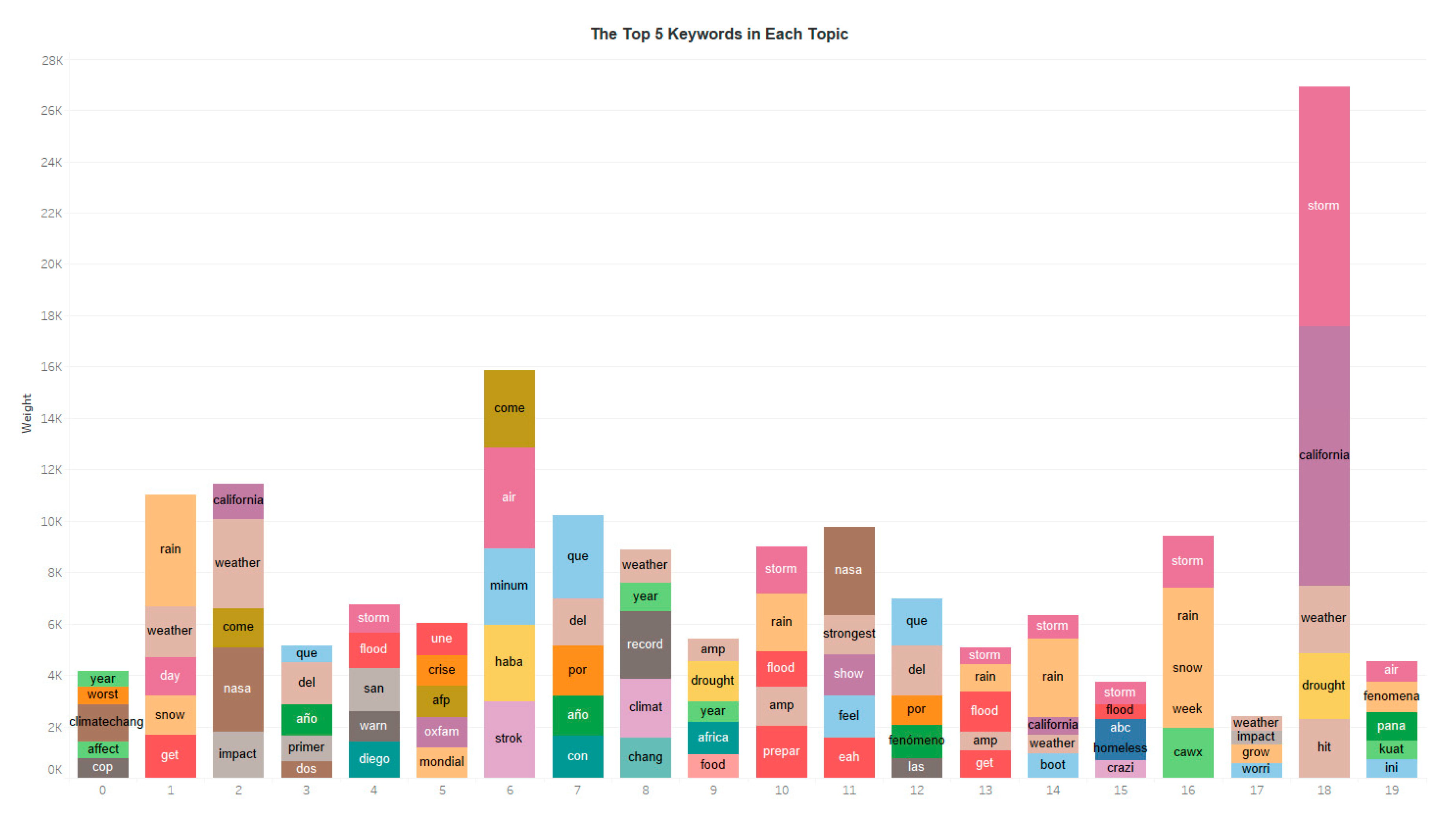
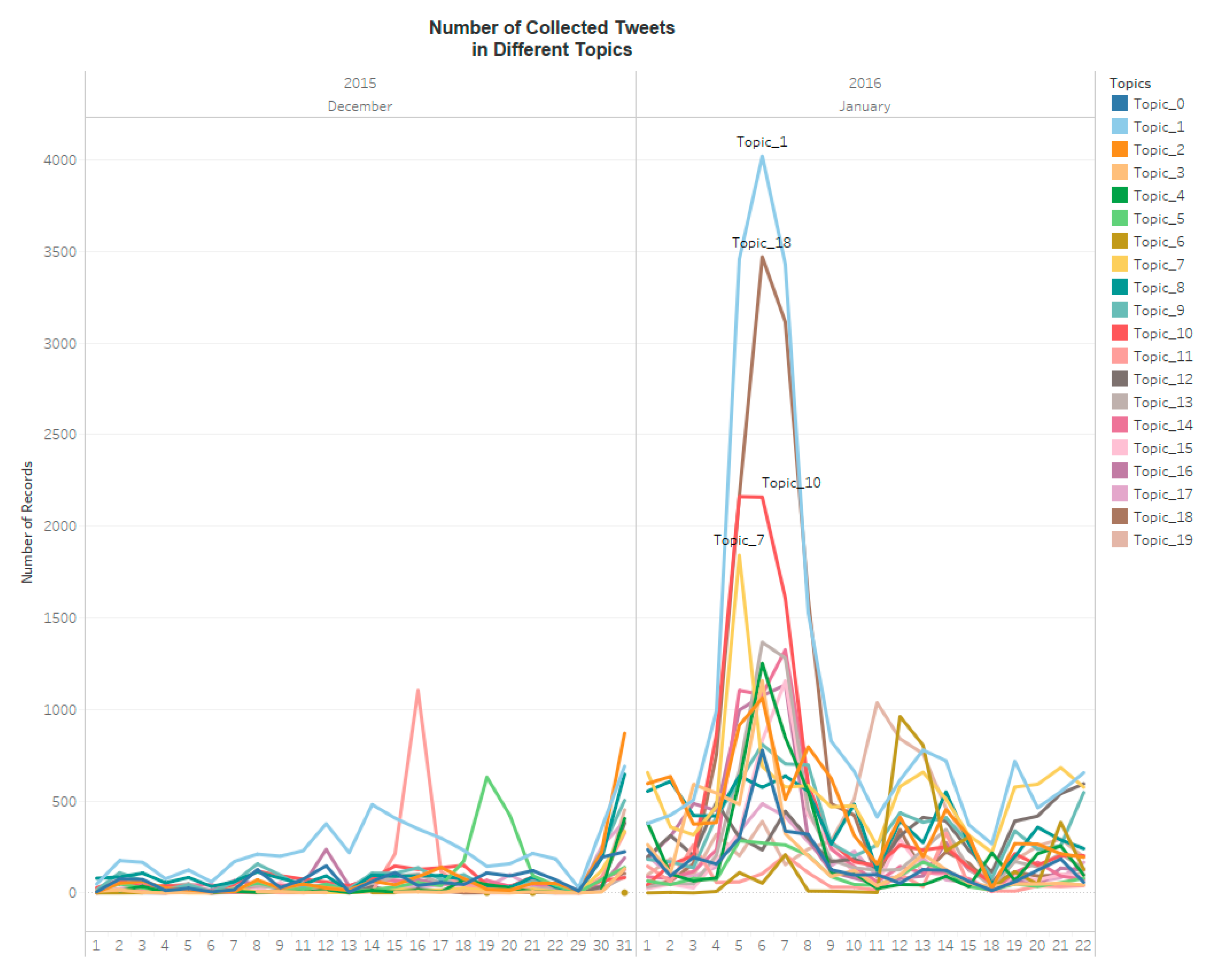
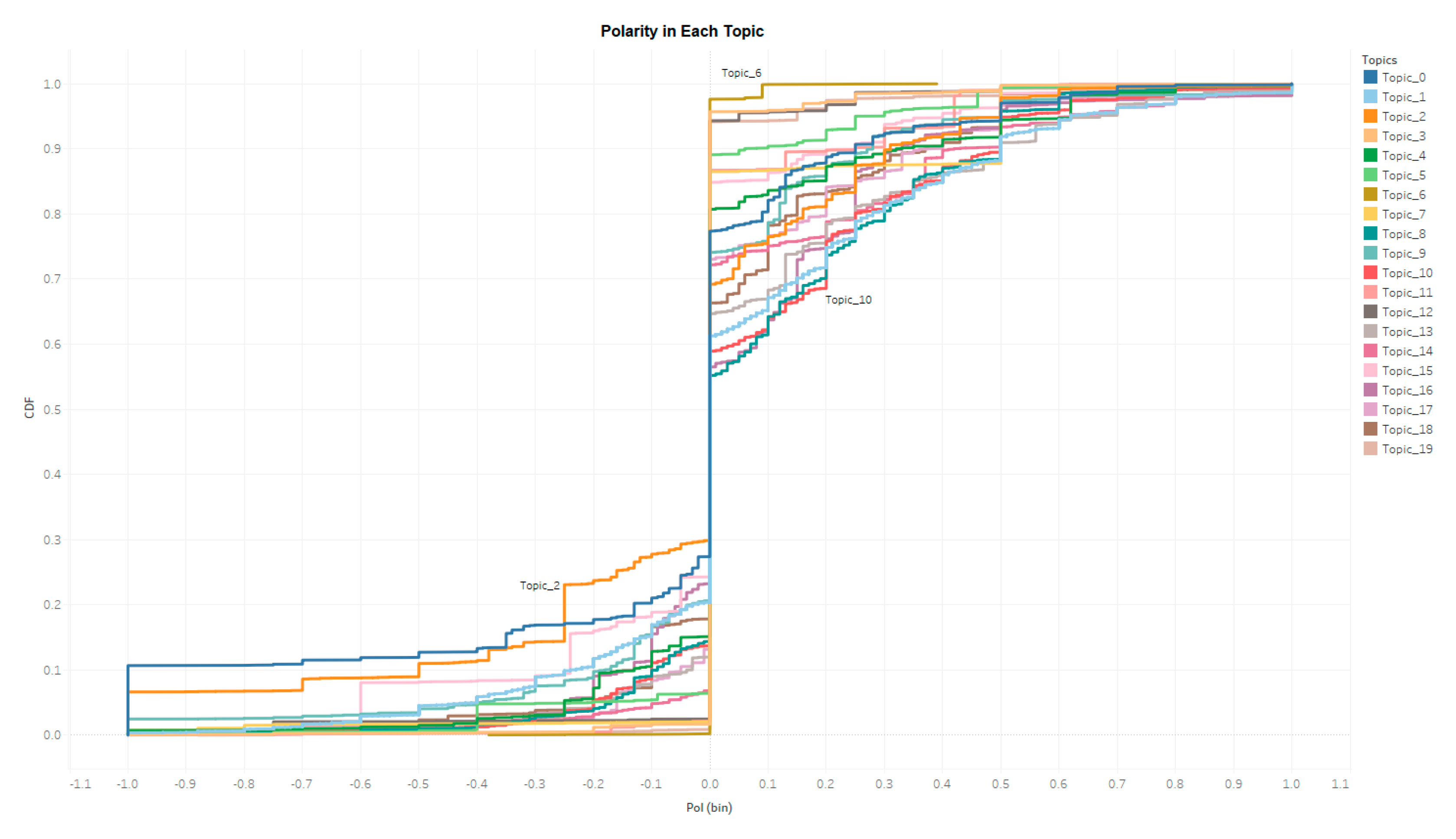




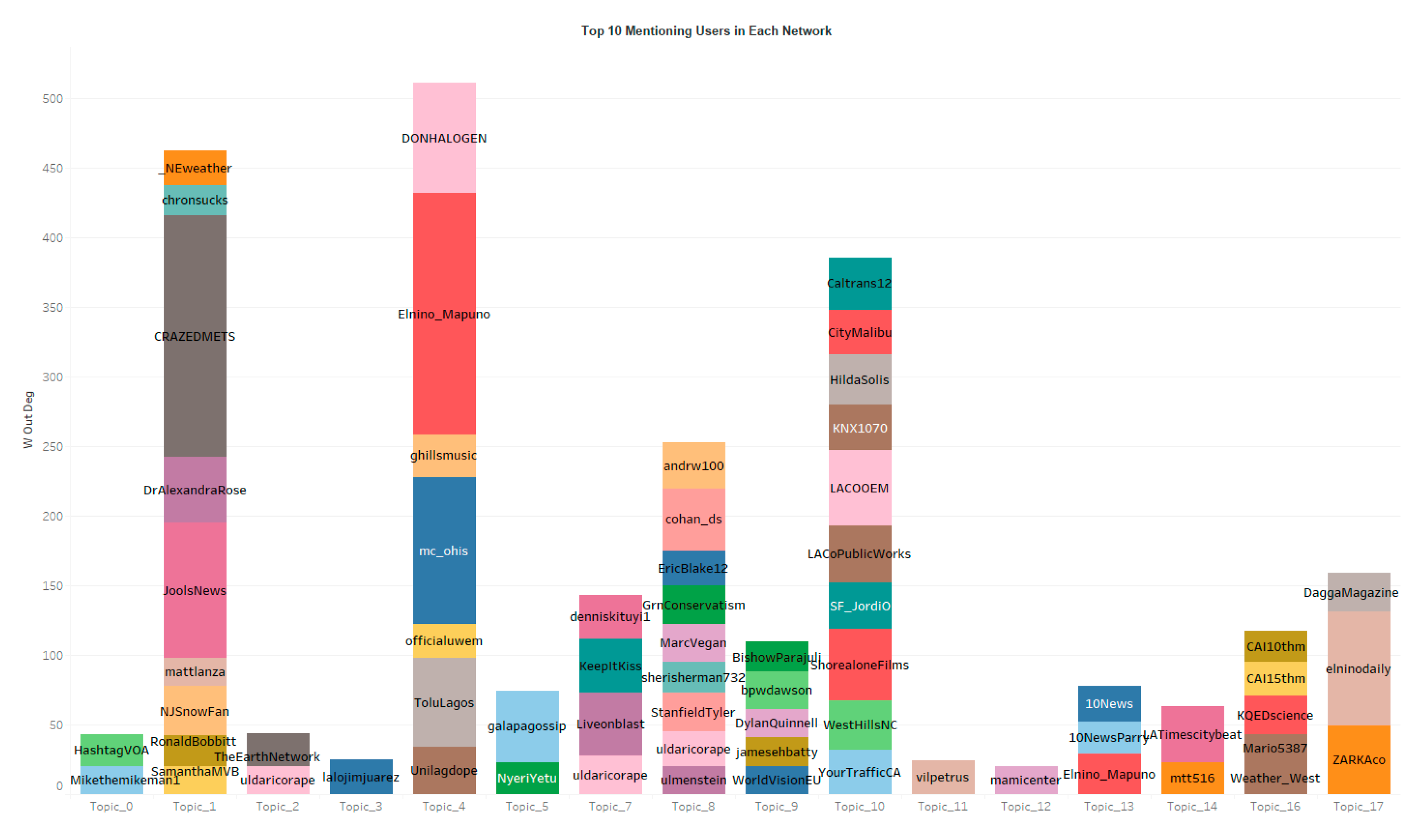
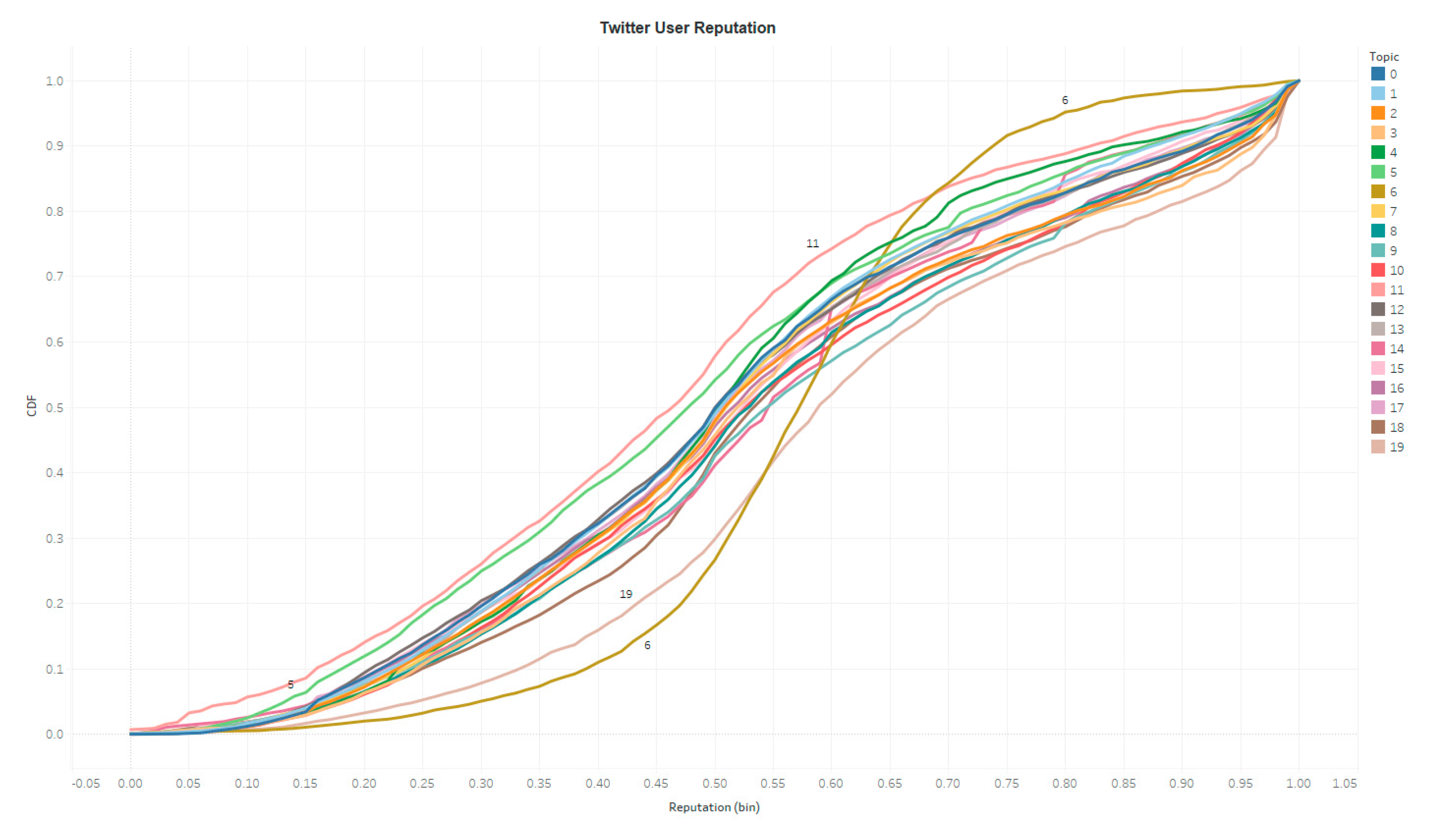



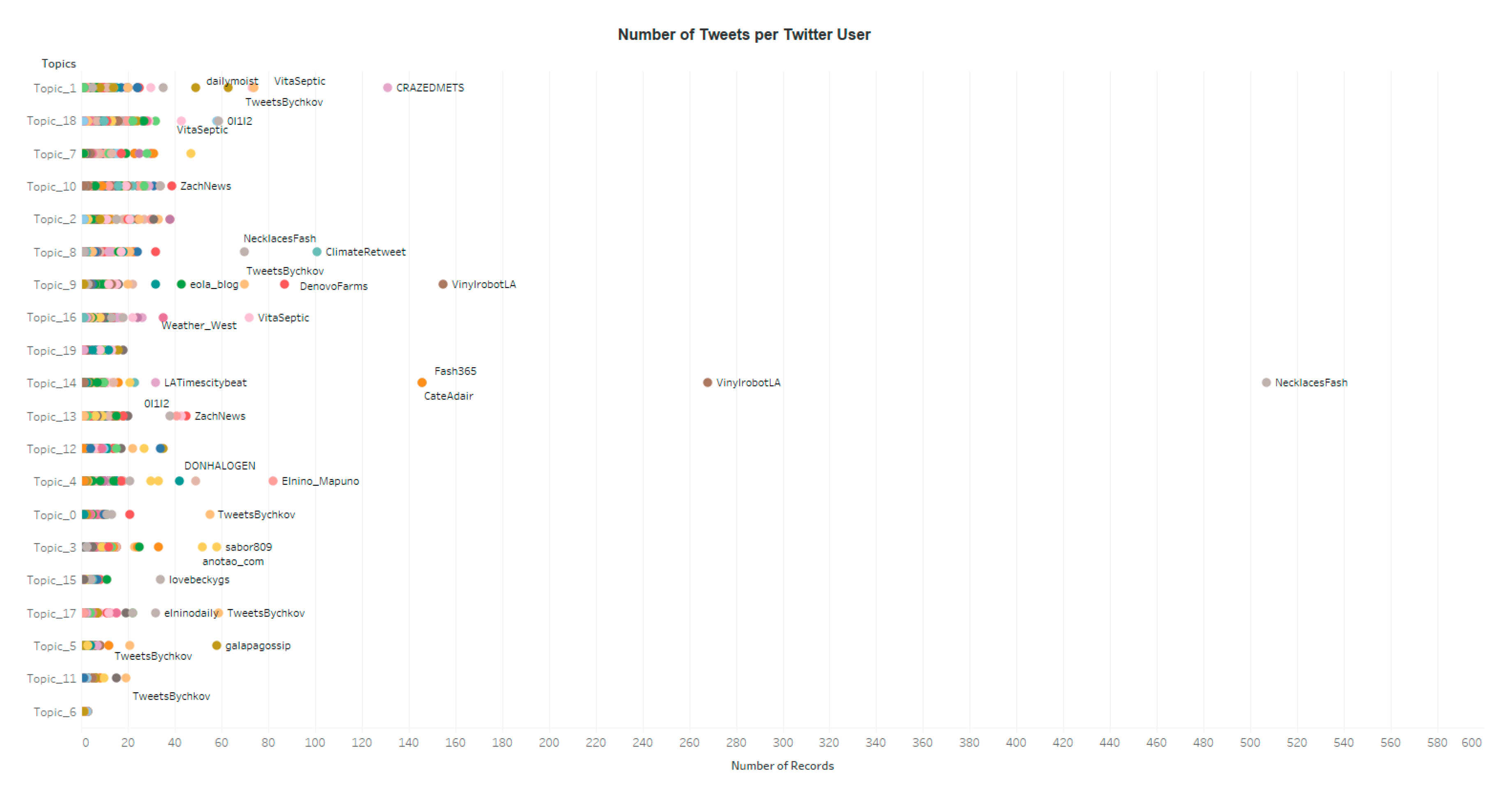


© 2019 by the authors. Licensee MDPI, Basel, Switzerland. This article is an open access article distributed under the terms and conditions of the Creative Commons Attribution (CC BY) license (http://creativecommons.org/licenses/by/4.0/).
Share and Cite
Ye, X.; Wei, X. A Multi-Dimensional Analysis of El Niño on Twitter: Spatial, Social, Temporal, and Semantic Perspectives. ISPRS Int. J. Geo-Inf. 2019, 8, 436. https://0-doi-org.brum.beds.ac.uk/10.3390/ijgi8100436
Ye X, Wei X. A Multi-Dimensional Analysis of El Niño on Twitter: Spatial, Social, Temporal, and Semantic Perspectives. ISPRS International Journal of Geo-Information. 2019; 8(10):436. https://0-doi-org.brum.beds.ac.uk/10.3390/ijgi8100436
Chicago/Turabian StyleYe, Xinyue, and Xuebin Wei. 2019. "A Multi-Dimensional Analysis of El Niño on Twitter: Spatial, Social, Temporal, and Semantic Perspectives" ISPRS International Journal of Geo-Information 8, no. 10: 436. https://0-doi-org.brum.beds.ac.uk/10.3390/ijgi8100436




